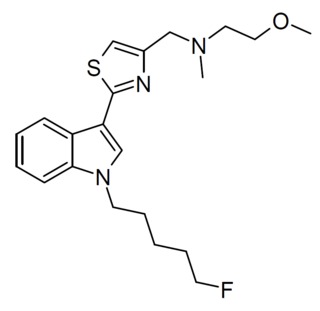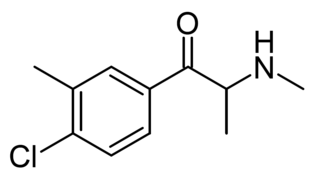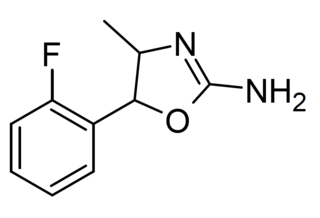
4-Methylaminorex is a stimulant drug of the 2-amino-5-aryloxazoline class that was first synthesized in 1960 by McNeil Laboratories. It is also known by its street name "U4Euh" ("Euphoria"). It is banned in many countries as a stimulant.

Aminorex is a weight loss (anorectic) stimulant drug. It was withdrawn from the market after it was found to cause pulmonary hypertension. In the U.S., it is an illegal Schedule I drug, meaning it has high abuse potential, no accepted medical use, and a poor safety profile.

Fluminorex is a centrally acting sympathomimetic which is related to other drugs such as aminorex and pemoline. It was developed as an appetite suppressant by McNeil Laboratories in the 1950s.

Clominorex is a centrally acting sympathomimetic which is related to other drugs such as aminorex and pemoline. It was developed as an appetite suppressant by McNeil Laboratories in the 1950s.

Substituted cathinones, which include some stimulants and entactogens, are derivatives of cathinone. They feature a phenethylamine core with an alkyl group attached to the alpha carbon, and a ketone group attached to the beta carbon, along with additional substitutions. Cathinone occurs naturally in the plant khat whose leaves are chewed as a recreational drug.

α-Pyrrolidinohexiophenone is a synthetic stimulant drug of the cathinone class developed in the 1960s which has been reported as a novel designer drug.

5F-AB-FUPPYCA (also known as AZ-037) is a pyrazole-based synthetic cannabinoid that is presumed to be an agonist of the CB1 receptor and has been sold online as a designer drug. It was first detected by the EMCDDA as part of a seizure of 540 g white powder in France in February 2015.

Substituted phenylmorpholines, or substituted phenmetrazines alternatively, are chemical derivatives of phenylmorpholine or of the psychostimulant drug phenmetrazine. Most such compounds act as releasers of monoamine neurotransmitters, and have stimulant effects. Some also act as agonists at serotonin receptors, and compounds with an N-propyl substitution act as dopamine receptor agonists. A number of derivatives from this class have been investigated for medical applications, such as for use as anorectics or medications for the treatment of ADHD. Some compounds have also become subject to illicit use as designer drugs.

2-Fluorodeschloroketamine is a dissociative anesthetic related to ketamine. Its sale and use as a designer drug has been reported in various countries. It is an analogue of ketamine where the chlorine group has been replaced by fluorine. Due to its recent emergence, the pharmacological specifics of the compound are mostly unclear, but effects are reported to be similar to its parent compound, ketamine.

5-Chloro-β-keto-methiopropamine (5-Cl-βk-MPA) is a recreational designer drug with stimulant effects. It is a substituted cathinone derivative with a thiophene core, closely related to better known drugs such as βk-Methiopropamine and mephedrene.

ZDCM-04 is a recreational designer drug with psychedelic effects. It is a phenethylamine derivative which is thought to act as a prodrug for DOC and theophylline in the same way in which fenethylline acts as a prodrug for amphetamine and theophylline. ZDCM-04 was made illegal in Italy in March 2020.

2C-B-aminorex (2C-B-AR) is a recreational designer drug with psychedelic effects. It is a substituted aminorex derivative which was first identified in Sweden in June 2019.

PTI-3 is an indole-3-thiazole based synthetic cannabinoid which has been sold as a designer drug. It was first identified in Hungary in 2020, and was made illegal in Italy in June 2021.

3',4'-Methylenedioxy-4-methylaminorex (MDMAR) is a recreational designer drug from the substituted aminorex family, with monoamine releasing effects.

4-Chloro-3-Methylmethcathinone (4-Cl-3-MMC) is a chemical compound from the substituted cathinone family. It has stimulant effects, and has been sold as a designer drug. It was first identified in Sweden in 2021. It is illegal in Italy and Finland, as well as under generic legislation in various other jurisdictions.

4'-Chloro-4-methylaminorex is a recreational designer drug from the substituted aminorex family, with stimulant effects. It has reportedly been sold since around 2021 and was first definitively identified in Austria in January 2022.

2'-Fluoro-4-methylaminorex is a recreational designer drug from the substituted aminorex family, with stimulant effects, first reported in 2018.

4'-Bromo-4-methylaminorex is a designer drug from the substituted aminorex family, first definitively identified in Austria in January 2022. Its pharmacological activity has not been reported, but it is believed to have stimulant effects.


















